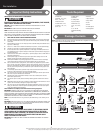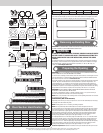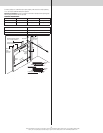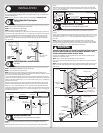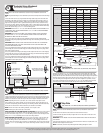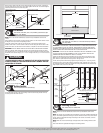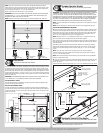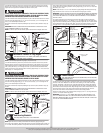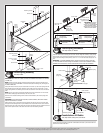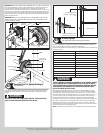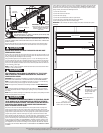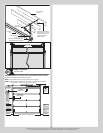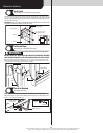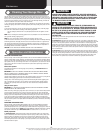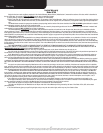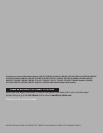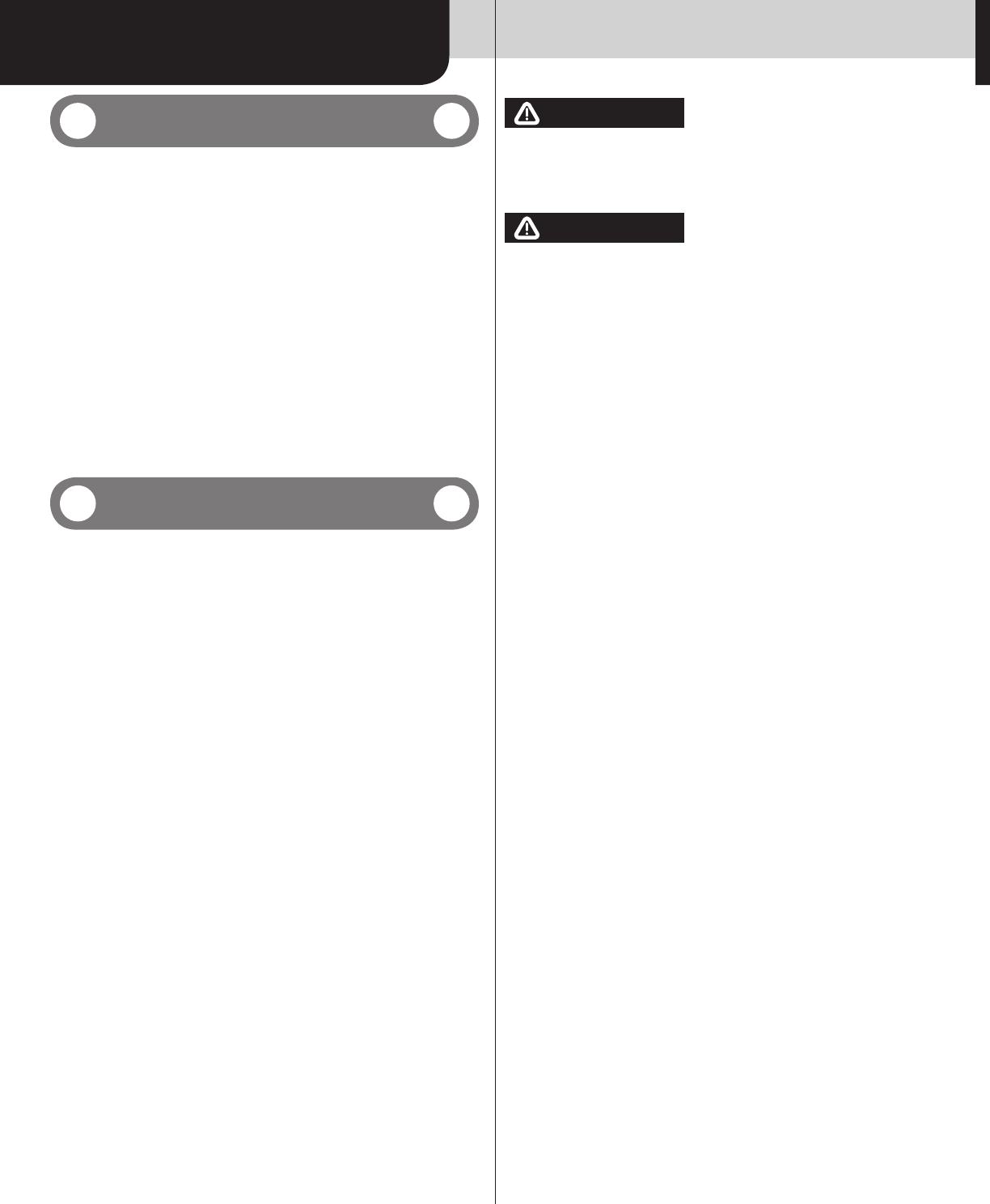
Cleaning Your Garage Door
Like any other exterior surface, Wayne-Dalton garage doors will have dirt exposure from atmo-
spheric conditions. Ordinarily, the cleaning action of rainfall will be adequate to wash the door, or
the door can be washed periodically by hosing with a garden hose and clear water (in particular)
for the areas not accessible to rain. If you desire to do a more thorough cleaning, or where soil
collection conditions occur, follow these simple instructions.
1. Use a soft-bristled, long-handled washing brush. It attaches to your garden hose and makes
washing your garage door easier. Do not rub vigorously which may create glossy areas over the
vinyl finish.
2. For hard-to-remove dirt, such as soot and grime found in industrial areas, wash the garage
door down with a mild solution consisting of the following ingredients:
One cup detergent (with less than 0.5% phosphate) dissolved into five gallons of warm
water.
NOTE: The use of detergents containing greater than 0.5% phosphate is not recommended for
use in general cleaning of garage doors.
NOTE: Be sure to clean behind weather stripping on both sides and top of door.
3. Start at the bottom and work up to the top, as less streaking will result. Immediately following
all washing operations, thoroughly rinse the surface area with fresh water from a garden hose.
This cleaning and maintenance information is suggested in an effort to be of assistance; how-
ever, manufacturer cannot assume responsibility for results obtained which are dependent on
the cleaning solution and method of application.
CAUTION: DO NOT PAINT DOOR. PAINTING DOOR WILL VOID YOUR WARRANTY.
Operation and Maintenance
OPERATING YOUR GARAGE DOOR…
Before you begin, read all warning labels affixed to the door and the installation instructions and
owner’s manual. When correctly installed, your Wayne-Dalton door will operate smoothly. Always
operate your door with controlled movements. Do not slam your door or throw your door into the
open position, this may cause damage to the door or its components. If your door has an electric
opener, refer to the owner’s manual to disconnect the opener before performing manual door
operation below.
Manual door operation:
For additional information on manual garage door operations go to www.dasma.com and
reference TDS 165.
IMPORTANT: DO NOT PLACE FINGERS OR HANDS INTO SECTION JOINTS WHEN OPENING
AND/OR CLOSING A DOOR. IF PROVIDED, ALWAYS USE LIFT HANDLES/ SUITABLE GRIPPING
POINTS WHEN OPERATING THE DOOR MANUALLY.
Opening a Door: Make sure the lock(s) are in the unlocked position. Lift the door by using the lift
handles/ suitable gripping points only. Door should open with little resistance.
Closing a Door: From inside the garage, pull door downward using lift handles/ gripping point
only or a high friction area only. If you are unable to reach the lift handles/ suitable gripping
points only, use pull rope affixed to the side of door. Door should close completely with little
resistance.
Using an electric opener:
IMPORTANT: PULL ROPES MUST BE REMOVED AND LOCKS MUST BE REMOVED OR MADE
INOPERATIVE IN THE UNLOCKED POSITION.
When connecting a trolley type garage door opener to this door, an opener and/or trolley bracket
must be securely attached to the top section of the door, along with any struts provided with
the door. Always use the opener and/or trolley bracket supplied with the door. To avoid possible
damage to your door, Wayne-Dalton recommends reinforcing the top section with a strut (may
or may not be supplied). The installation of the opener must be according to manufacturer’s
instructions and force settings must be adjusted properly. Refer to the owner’s manual supplied
with your electric opener for complete details on installation, operation, maintenance and testing
of the opener.
MAINTAINING YOUR GARAGE DOOR…
Before you begin, read all warning labels affixed to the door and the installation instructions
and owner’s manual. Perform routine maintenance steps once a month, and have the door
professionally inspected once a year. Review your Owner’s Manual for the garage door. These in-
structions are available online at www.Wayne-Dalton.com. For additional information on garage
door/opener maintenance go to www.dasma.com and reference TDS 151, 167 and 179.
Monthly Inspections:
1. Visual Inspection: Closely inspect jambs, header and mounting surface. Any wood found
not to be structurally sound must be replaced. Inspect the springs, cables, rollers, pulleys, back
hangs and other door hardware for signs of worn or broken parts. Tighten any loose screws
and/or bolts. Check exterior surface of the door sections for any minor cracks. Verify door has
not shifted right and/or left in the opening. If you suspect problems, have a trained door system
technician make the repairs.
WARNING WARNING
GARAGE DOOR SPRINGS, CABLES, BRACKETS, AND OTHER HARDWARE AT-
TACHED TO THE SPRINGS ARE UNDER EXTREME TENSION, AND IF HANDLED
IMPROPERLY, CAN CAUSE SEVERE OR FATAL INJURY. ONLY A TRAINED DOOR
SYSTEM TECHNICIAN SHOULD ADJUST THEM, BY CAREFULLY FOLLOWING
THE MANUFACTURER’S INSTRUCTIONS.
WARNING WARNING
NEVER REMOVE, ADJUST, OR LOOSEN THE BOLTS, SCREWS AND/OR LAG
SCREWS ON THE COUNTERBALANCE (END OR CENTER BEARING BRACKETS)
SYSTEM OR BOTTOM BRACKETS OF THE DOOR. THESE BRACKETS ARE CON-
NECTED TO THE SPRING(S) AND ARE UNDER EXTREME TENSION. TO AVOID
POSSIBLE SEVERE OR FATAL INJURY, HAVE ANY SUCH WORK PERFORMED
BY A TRAINED DOOR SYSTEMS TECHNICIAN USING PROPER TOOLS AND
INSTRUCTIONS.
Torsion Springs: The torsion springs (located above the door) should only be adjusted by a
trained door systems technician.
2. Door Balance: Periodically test the balance of your door. If you have a garage door opener,
use the release mechanism so you can operate the door by hand when doing this test. Start with
the door in the fully closed position. Lift the door to check its balance. Torsion spring(s) need
adjustment if door lifts by itself (hard to pull down) or if door is difficult to lift (easy to pull down).
DO NOT attempt to repair or adjust Torsion Springs yourself. DO NOT attempt to repair or adjust
Torsion Springs yourself. Contact a trained door system technician to adjust springs using proper
tools and instructions.
3. Lubrication: The door should open and close smoothly. Ensure the door rollers are rotating
freely when opening and closing the door. If rollers do not rotate freely, clean the door tracks, re-
moving dirt and any foreign substances. Clean and lubricate (use a non-silicon based lubricant)
hinges, steel rollers and bearings. DO NOT lubricate plastic idler bearings, nylon rollers, door
track. DO NOT oil a cylinder lock, if actuation is difficult use a graphite dust to lubricate.
16
Please Do Not Return This Product To The Store. Contact your local Wayne-Dalton dealer. To find your local Wayne-Dalton dealer,
refer to your local yellow pages business listings or go to the Find a Dealer section online at www.Wayne-Dalton.com
Maintenance



